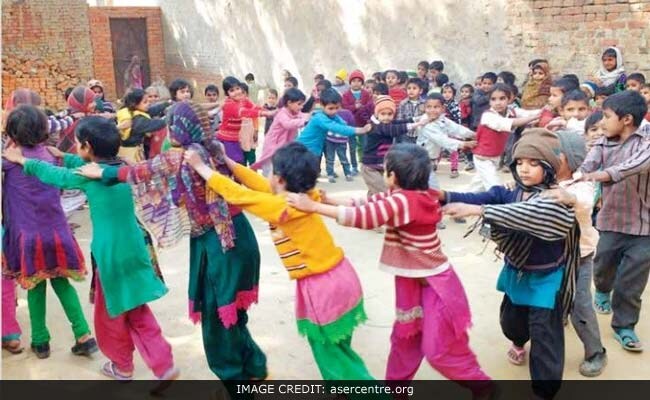
ASER 2016: The government schools fares well in performance than that of private schools
New Delhi:
The government schools fares well in performance than that of private schools, according to the Annual Status of Education Report, ASER 2016 which was released in New Delhi on January 18 after a break of one year in 2015 by ASER volunteers. ASER is the largest annual household survey in rural India that focuses on the status of children's schooling and basic learning. Facilitated by Pratham, the survey is carried out by volunteers from local partner organizations in almost all rural districts of India. ASER 2016 reached 589 rural districts. The survey was carried out in 17,473 villages, covering 350,232 households and 562,305 children in the age group 3-16.
According to the survey, there was no increase in private school enrollment between 2014 and 2016, however, two states show significant increases in government school enrollment relative to 2014 levels. In Kerala, the proportion of children (age 11-14) enrolled in government school increased from 40.6% in 2014 to 49.9% in 2016. In Gujarat, this proportion increased from 79.2% in 2014 to 86% in 2016.
When it comes to reading ability, nationally, it has improved especially in early grades in government schools. Nationally, the proportion of children in Std III who are able to read at least Std I level text has gone up slightly, from 40.2% in 2014 to 42.5% in 2016. This proportion shows substantial increases among children in government schools in many states: Punjab, Uttarakhand, Haryana, Chhattisgarh, Gujarat, Maharashtra and Telangana. The report argue that, this improvement is driven by gains in learning levels in government schools in these states.
In arithmetic, in 2014, 25.4% of Std III children could do a 2-digit subtraction. This number has risen slightly to 27.7% in 2016. This improvement has come primarily from government schools where the percentage of Std III children who could do a 2-digit subtraction increased from 17.2% in 2014 to 20.2% in 2016.
In an overall level, according to the report findings, ability to read English is unchanged for lower primary grades. In comparison, in 2016, 24.5% of children enrolled in Std V could read simple English sentences. This number is virtually unchanged since 2009. However, a few states show improvements since 2014 for government school children enrolled in Std V.
Click here for more Education News
According to the survey, there was no increase in private school enrollment between 2014 and 2016, however, two states show significant increases in government school enrollment relative to 2014 levels. In Kerala, the proportion of children (age 11-14) enrolled in government school increased from 40.6% in 2014 to 49.9% in 2016. In Gujarat, this proportion increased from 79.2% in 2014 to 86% in 2016.
When it comes to reading ability, nationally, it has improved especially in early grades in government schools. Nationally, the proportion of children in Std III who are able to read at least Std I level text has gone up slightly, from 40.2% in 2014 to 42.5% in 2016. This proportion shows substantial increases among children in government schools in many states: Punjab, Uttarakhand, Haryana, Chhattisgarh, Gujarat, Maharashtra and Telangana. The report argue that, this improvement is driven by gains in learning levels in government schools in these states.
In arithmetic, in 2014, 25.4% of Std III children could do a 2-digit subtraction. This number has risen slightly to 27.7% in 2016. This improvement has come primarily from government schools where the percentage of Std III children who could do a 2-digit subtraction increased from 17.2% in 2014 to 20.2% in 2016.
In an overall level, according to the report findings, ability to read English is unchanged for lower primary grades. In comparison, in 2016, 24.5% of children enrolled in Std V could read simple English sentences. This number is virtually unchanged since 2009. However, a few states show improvements since 2014 for government school children enrolled in Std V.
Click here for more Education News
